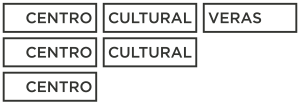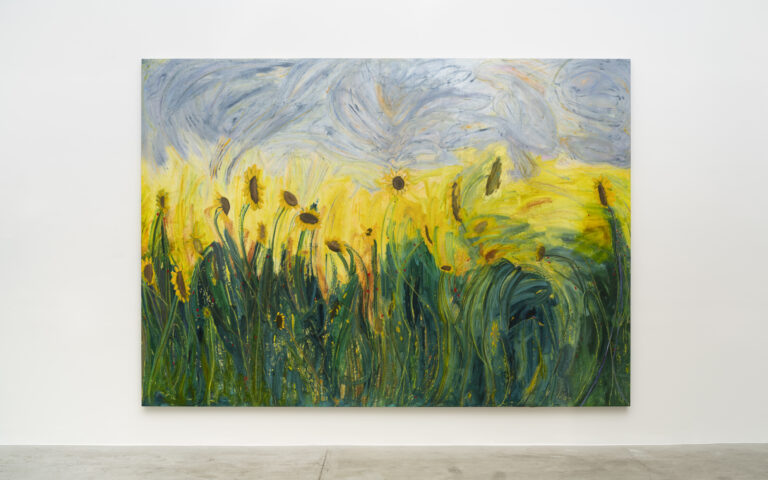

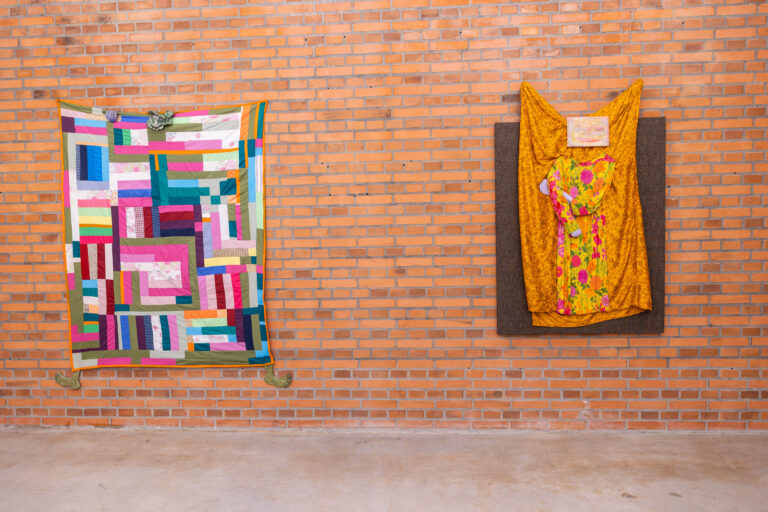
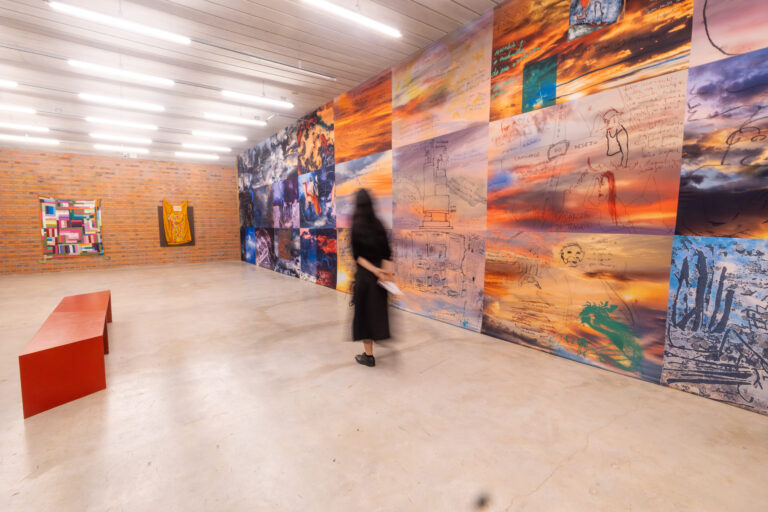
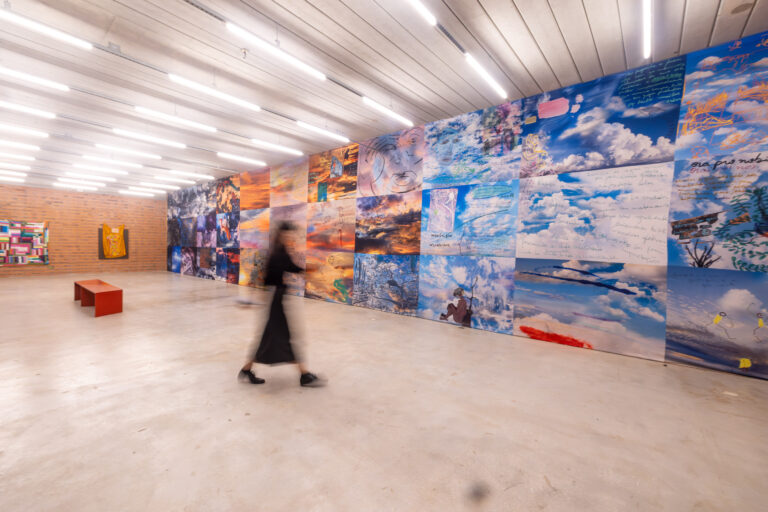
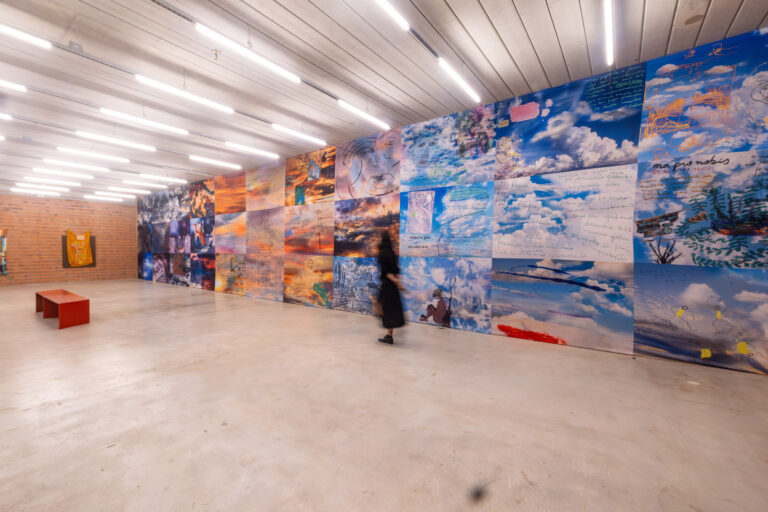
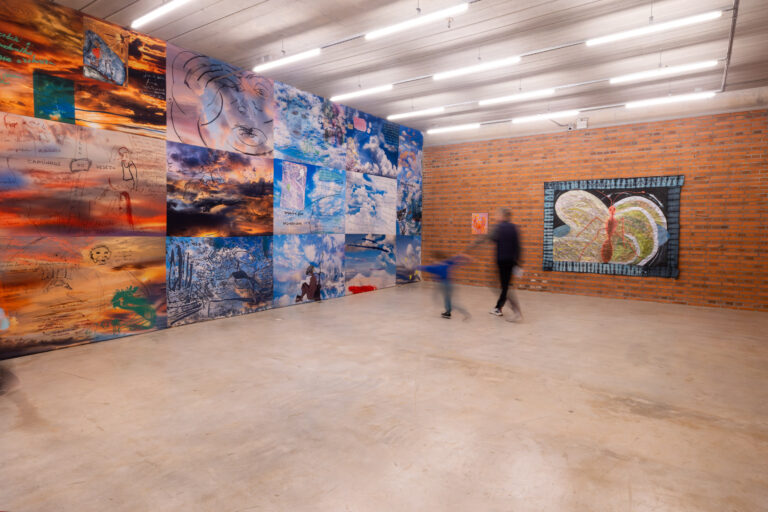
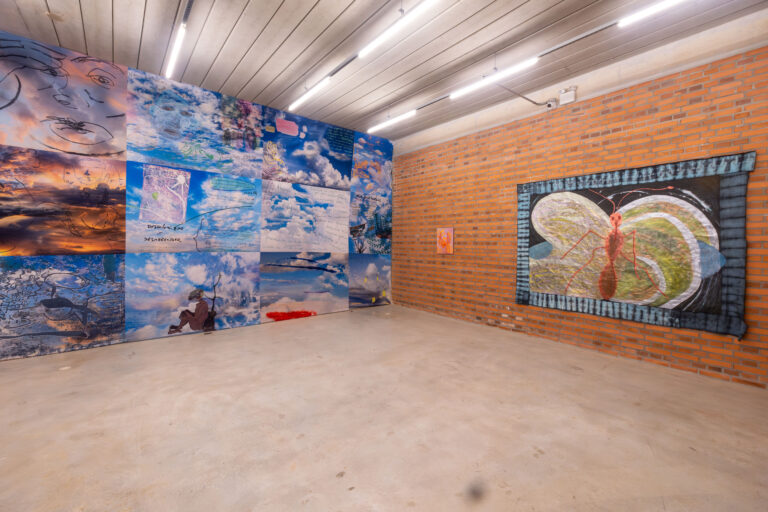
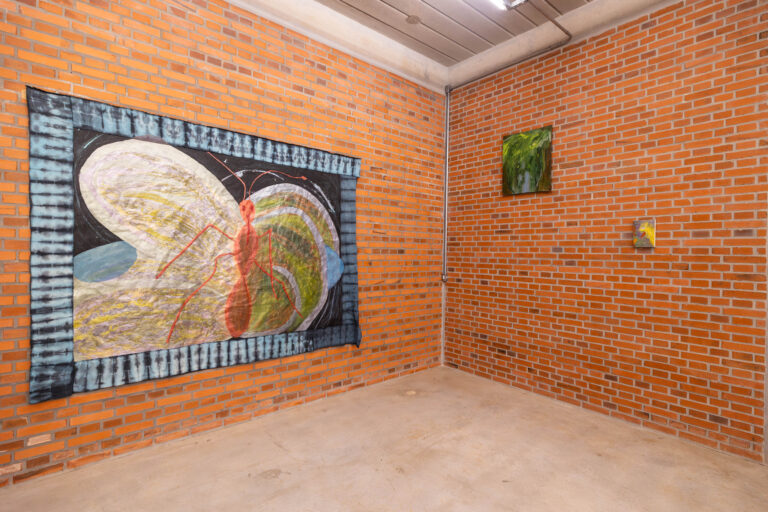
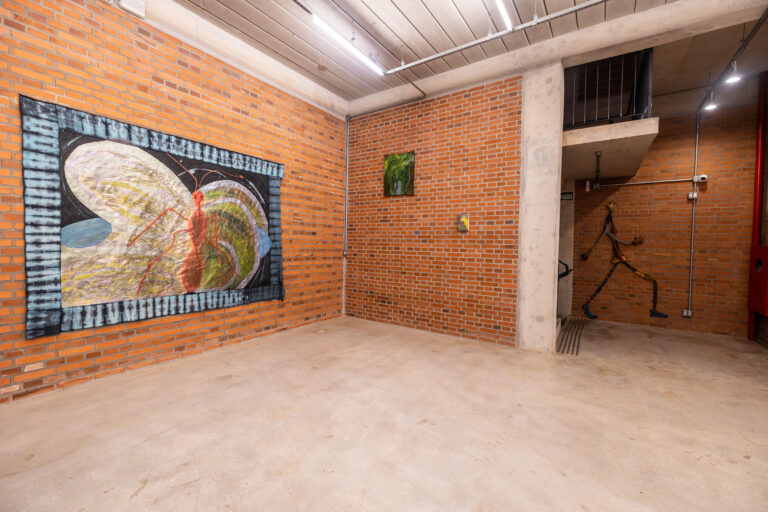
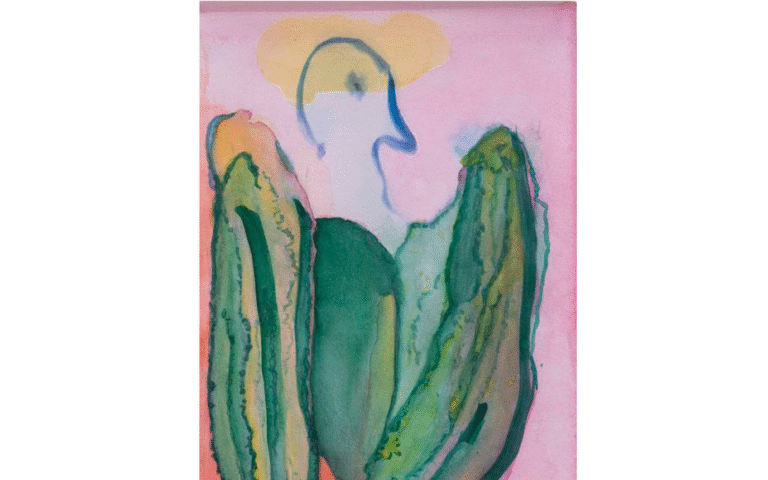
Gokula Stoffel – Continuar a ser
Josué Mattos
As massas de cor derivadas de gestos com aparência inacabada em matéria densa geram seres imaginários, desesperados, estranhos e afetivos em boa parte da produção de escultura que Gokula Stoffel vem desenvolvendo ao longo dos últimos anos. A ação consiste em acolher nas pontas dos dedos a unidade-diferença que compreende toda forma de vida responsável por ativar espanto e deleite com o mistério contido nas grandes interrogações que atravessam a passagem do tempo (continuar) e a existência (a ser). Entre as esculturas de Continuar a ser, aquelas conectadas por fios transformados em membros agigantados dão movimento às memórias táteis da matéria, acolhendo placidez e desespero, delicadeza e rudez.
Talvez por isso a exposição propõe um convite ao movimento e pausa simultâneos, assim como o pássaro pousado em equilíbrio sobre um tronco é levado pela correnteza de um rio caudaloso, ensinamento do iogue ao mestre Gil. A montagem propõe encarar a continuidade como dádiva e luta contra a barbárie que invalida existências e arruína as diferenças. O conjunto de obras é a observação não exaustiva de formas de vida que nascem antes e morrem depois de quem dura o tempo de um passeio de fim de semana com a mesma presença de espécies que acumulam centenários. Diante de uma assembleia diversa, temporariamente coabitante — o boto, o bode e a borboleta, a moça-raivosa escondida atrás de sua veste-castelo, o menino-árvore solto em céu enevoado ou o urubu pousado com seu olhar de perfil —, cada forma devolve ao espectador a equivalência que consiste em tocar a matéria enquanto é tocado por corpos anônimos e multiespécies. De igual modo, os vendavais em campos de girassóis que anunciam silhuetas esvoaçantes, feitas de fúria e beleza sublimes, ou a evaporação calorosa e a luminescência esmaecida gerada pelo diálogo de indivíduos que se transformam desde o mínimo contato, tal como água e fogo, aproximam o gesto escultórico de práticas pictóricas que convocam as mãos, não apenas os pincéis, para cobrir superfícies com cores que fazem alusão ao ímpeto incontrolável da natureza. Inclusive, a costura de retalhos parece possuir o mesmo valor plástico e narrativo, no sentido em que desfaz a hierarquia de linguagens e convoca pequenas partes de tecidos a se tornarem estandartes que comunicam a integração pulsante do diverso.
Em paisagens presas umas às outras, imagens de alvoradas, sol a pino e crepúsculos relembram o público da existência de dias e noites em alguma parte do mundo. Sobre as paisagens, imagens não humanas expressam espanto frente às hegemonias culturais que restringem o direito à vida seguindo parâmetros de civilizações devastadoras. Portanto, a exposição Continuar a ser observa com espanto a parcela da sociedade que insiste em deter poder com a finalidade de definir auspícios e assombrações, o que se aplica ao morcego, uma das obras centrais da exposição ao carregar sua identidade ambígua, associada à felicidade chinesa e ao pavor medieval europeu.
Ao tomar emprestado o título de uma obra realizada pela artista em 2022, quando a banalização da morte e o pavor derivados de crises globais davam alguma trégua e faziam uma parcela da população vislumbrar alucinadamente uma nova era, em 2025, Continuar a ser segue sendo o lema da floresta, de populações diaspóricas, de espécies que nascem objetificadas. É, também, o grito da vida que incita cuidado em campo minado e insiste em seguir sendo.
Texto produzido na ocasião de Gokula Stoffel – Continuar a ser
Centro Cultural Veras, Florianópolis. 24/05/2025 – 02/08/2025
© 2025 [Josué Mattos – Centro Cultural Veras]. Todos os direitos reservados. A reprodução, no todo ou em parte, só é permitida com autorização expressa do autor.
Gokula Stoffel – To Continue Being
Josué Mattos
Masses of color born from gestures, with an unfinished appearance and dense with matter, generate imaginary, desperate, strange, and affectionate beings throughout much of the sculptural work Gokula Stoffel has developed over recent years. The act involves welcoming, at the fingertips, the unity-difference that encompasses all forms of life—responsible for sparking awe and delight in the face of the mystery contained in the great questions that run through the passage of time (to continue) and of existence (to be). Among the sculptures in Continuar a Ser [To Continue Being], those connected by wires transformed into oversized limbs give movement to the tactile memories of matter, embracing both serenity and despair, delicacy and roughness.
Perhaps for this reason, the exhibition invites movement and stillness at once, like a bird perched in balance on a branch, carried by the current of a mighty river—a teaching from the yogi to master Gilberto Gil. The exhibition proposes to regard continuity as both a gift and a struggle against the barbarism that invalidates lives and destroys differences. The body of work offers a non-exhaustive observation of forms of life that are born before and die after those who last as long as a weekend stroll—sharing a presence with species that count their lifespans in centuries. Before a diverse, temporarily cohabiting assembly—the river dolphin, the goat, the butterfly, the angry girl hidden behind her castle-gown, the tree-boy adrift in a misty sky, or the vulture perched with its profile gaze—each form returns to the viewer an equivalence that lies in touching matter while being touched by anonymous, multispecies bodies.
Likewise, the gusts of wind in sunflower fields that announce fluttering silhouettes made of sublime fury and beauty, or the warm evaporation and faded luminescence born of a dialogue between individuals who transform with even the smallest contact—like water and fire—bring the sculptural gesture closer to pictorial practices that call upon hands, not just brushes, to cover surfaces with colors that allude to the uncontrollable impulse of nature. Patchwork stitching, too, seems to carry the same plastic and narrative value, in the way it undoes the hierarchy of languages and summons small pieces of fabric to become banners that communicate the pulsing integration of diversity.
In landscapes fused together, images of dawn, high noon, and dusk remind the public of the presence of days and nights somewhere in the world. Upon these landscapes, non-human figures express astonishment at cultural hegemonies that restrict the right to life according to the parameters of devastating civilizations. Thus, the exhibition To Continue Being gazes in amazement at the part of society that insists on holding power to define omens and hauntings—a role embodied by the bat, one of the central works of the show, bearing its ambiguous identity linked to both Chinese happiness and medieval European dread.
By borrowing the title from a work the artist created in 2022—when the normalization of death and the fear derived from global crises had momentarily subsided, allowing part of the population to deliriously envision a new era—in 2025, To Continue Being remains the motto of the forest, of diasporic populations, of species born objectified. It is also the cry of life that calls for care in a minefield and insists on continuing to be.
Text produced on the occasion of Gokula Stoffel – To Continue Being
Centro Cultural Veras, Florianópolis. May 24, 2025 – August 2, 2025
© 2025 [Josué Mattos – Centro Cultural Veras]. All rights reserved. Reproduction, in whole or in part, is only permitted with the express authorization of the author.
O Centro Cultural Veras apresenta a exposição “Continuar a ser”, de Gokula Stoffel, com mais de 30 obras que ocupam a Sala Mira.
Data: 24 de maio a 2 de agosto de 2025
Horário: Terça a sexta: 14h – 21h | Sábado: 9h – 20h
Local: Centro Cultural Veras – R. Vera Linhares de Andrade, 2064, Córrego Grande, Florianópolis – SC
Entrada gratuita

